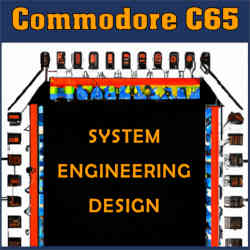Commodore 65: Exploring C64 Compatibility Challenges
Published 27 June 2023

Introduction
The Commodore 65, an ambitious project by Commodore Business Machines, was designed to succeed the Commodore 64 while maintaining backward compatibility with its software. The endeavor was intended to preserve the vast library of C64 software, thereby providing an upgrade path for existing C64 users without rendering their current software obsolete. However, this noble aspiration was fraught with compatibility issues due to significant enhancements in the C65's hardware and software architecture. Much of what we know about the Commodore C65 is described in detail in the technical specifications.
C64 Compatibility Issues
A primary area of concern was the CPU speed. The C65 featured a custom CSG 4510 R3 CPU, a MOS 6502 derivative, operating at a clock frequency of 3.54 MHz. This was over three times faster than the C64's 1 MHz CPU, which could lead to significant compatibility problems. Many software applications and games developed for the C64, particularly those that relied on precise timing, could run too fast or behave unpredictably when executed on the C65's faster processor. This aspect could have required considerable tweaking and adjustment to ensure proper operation.
Memory Management
The C65's expanded memory was another potential source of compatibility issues. This is clearly laid out in the Commodore C65 memory map. The C65 had a base memory of 128 KB, with the capability to expand to 4 MB. This was a significant leap from the C64's 64 KB of memory. While this additional memory would undoubtedly benefit new, more sophisticated applications, it could have posed problems for older C64 software. Software originally written for the C64's smaller memory space could potentially encounter issues when trying to run in the C65's larger memory environment.
VIC III Graphics Compatability
The graphic capabilities of the C65 also posed a potential challenge for compatibility. The C65 was equipped with an advanced VIC-III graphics chip, capable of rendering 256 colors from a palette of 4096 colors, and supporting multiple display modes, including resolutions up to 1280x400 pixels12. This was a considerable upgrade from the C64's VIC-II graphics chip, which could lead to compatibility issues. Software designed to leverage the C64's simpler graphics capabilities might not function correctly on the C65's advanced graphics system, potentially resulting in visual artifacts, glitches, or outright failures.
The VIC-III, the video chip of the Commodore 65, presented a significant upgrade over the VIC-II chip used in the Commodore 64, providing the C65 with superior graphic capabilities. Notably, the VIC-III could produce 256 colors from a palette of 4096 colors, a vast improvement over the VIC-II's 16 colors. Moreover, it supported higher resolutions, including modes such as 320×200×256, 640×200×16, 640×400×16, 1280×200×4, and 1280×400×4, which greatly exceeded the Commodore 64's maximum resolution of 320x200. In addition to supporting the C64's standard graphics modes, the VIC-III introduced new modes like 40 and 80 character columns by 25 rows, and true bitplane graphics, thereby expanding the C65's graphical capabilities. It also retained the 8x sprites of 24x21 pixels from the C64's VIC-II and introduced additional sprite capabilities via the new graphics modes. The VIC-III was also equipped with a Display Address Translator that allowed for direct access to bitplanes, further enhancing the graphic manipulation capabilities of the C6512.
Floppy Disk Drive
Finally, the choice of disk drive in the C65 also had implications for backward compatibility. Unlike the C64, which primarily used a 5.25-inch disk drive, the C65 featured a built-in 3.5-inch disk drive. This difference in disk media could create a significant barrier for C64 users seeking to upgrade, as the software they owned on 5.25-inch disks wouldn't be directly readable on the C65. While the C65 was reported to support the 1581 disk drive, it was not compatible with the 1541 or 1571 drives that were commonly used with the C641. This would have limited the ability of users to transfer software and data between the two systems using physical media.
Fun Fact: Despite the superior hardware of the C65 (which included a faster CPU, more RAM, and improved graphics and audio capabilities), when operating in C64 mode, the C65 had to limit its capabilities to match the performance and characteristics of the older model. This means that when running in C64 mode, it couldn't take full advantage of its enhanced hardware, and performed essentially like a Commodore 64! This was necessary to ensure software compatibility, as many C64 programs directly accessed the hardware and depended on the specific timing and behavior of the C64's components.
Conclusion
In summary, while the Commodore 65 was designed with the admirable goal of maintaining backward compatibility with the Commodore 64, the stark differences in hardware and software between the two systems presented significant challenges. These challenges could have potentially resulted in a broad range of compatibility issues. However, it is important to note that the C65 was never released to the mass market, so these compatibility issues were never fully tested or addressed in a real-world context.



